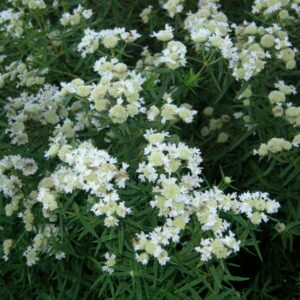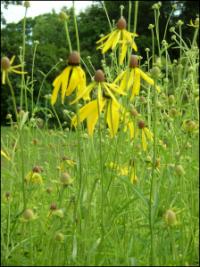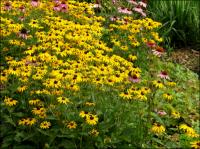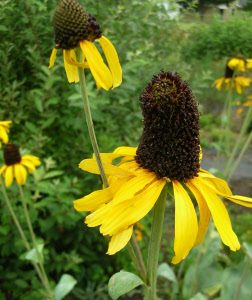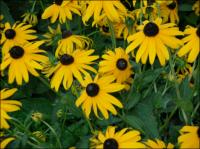Plants for Butterflies and Other Pollinators
Showing 153–160 of 223 results
-
Pycanthemum muticum Clustered Mountain Mint, Blunt Mountain Mint Z 4-8
Silvery bracts underlying silvery-pink pincushion flowers blooming from June to September. Flowers and leaves minty fragrance.
OUT OF STOCK
Silvery bracts underlying silvery-pink pincushion flowers blooming from June to September. Flowers and leaves minty fragrance.
Size: 12-36” x 12-36” spreading.
Care: sun to part shade in moist to well-drained soil incl. drought
Native: Maine to Michigan, south and angling southwest from Illinois to Texas
Wildlife Value: Deer resistant. One of highest nectar and pollen producing flowers attracting copious numbers and kinds of bees, butterflies, wasps and other insects.
Awards: Georgia Native Plant Society Plant of the Year 2022Collected and described by French botanist André Michaux (1746-1802) who spent 11 years exploring the North America for plants. 1800.
-
Pycanthemum virginianum Mountain mint Z 4-8
Corymbs of numerous pinkish-white blossoms, leaves fragrant.
Corymbs of numerous pinkish-white blossoms in August, leaves fragrant.
Size: 3' x 18"
Care: full sun to part shade in moist well-drained to well-drained soil
Native: Wisconsin native, Eastern U.S.
Wildlife Value: attracts butterflies, supports over 50 bee species.Named by Linnaeus in 1753. Pycanthemum is Greek meaning “dense blossom.” Chippewa used it to stop menstrual flow, cure chills and fever and to season meat. The plant gave the Meskwaki energy and lured minks into their traps. Lakota Sioux: “The leaves make a very pleasant tea. An infusion of the plant is taken for coughs.” Grown at America’s 1st botanic garden, Elgin Botanic Garden 1811
-
Ratibida pinnata Prairie coneflower Z 3-8
Skirt of drooping, sunny, thin petals surround erect brown cone on this fragrant flower, smelling of anise, June-August.
Skirt of drooping, sunny, thin petals surround erect brown cone on this fragrant flower, smelling of anise, June-August.
Size: 4' x 18"
Care: sun to part shade in any soil
Native: Ontario, VT to FL, SD to OK, incl. Wisconsin
Wildlife Value: Butterfly plant. Birds eat seeds.Pinnata means “feathery” in Latin referring to the thin petals of the flower. 1st Americans cured toothaches with the root & made tea from the cone and leaves. Collected by French explorer Michaux on the prairies of Illinois in 1795.
-
Rudbeckia fulgida Black eyed susan Z 4-9
The classic Black-eyed susan, 3" wide yellow daisies with a dark center from July-October
The classic Black-eyed susan, 3″ wide yellow daisies with a dark center from July – October
Size: 30" x 18"
Care: full sun to part shade in moist well-drained to well-drained soil
Native: Southeastern U.S.
Wildlife Value: A great number of bees, flies and beetles collect pollen or drink nectar from this RudbeckiaThis species fulgida was introduced to England in 1760 and named in William Aition’s Hortus Kewensis, V. 3 p. 251 (1789). Cherokee ate the stems and leaves and also used this species to remedy earaches, sores, flux, venereal disease, snakebites, dropsy, and swelling. Iroquois healed the heart and rid children of worms with this, Potawatomi make a brown dye with this.
-
Rudbeckia laciniata ‘Herbstsonne’ Rudbeckia nitida ‘Herbstsonne’ syn. Rudbeckia ‘Autumn Sun’ Z 5-10
Exceptionally large & drooping petals, with a tall, central cone of green, blooms July to September.
OUT OF STOCK
Exceptionally large & drooping petals, with a tall, central cone of green, blooms July to September.
Size: 4-7’ x 2-3’
Care: sun to part shade in moist well-drained soil
Wildlife Value: provides butterfly nectar and seeds food for birds
Awards: Royal Horticultural Society Award of Garden MeritIt’s “an old selection.”
-
Rudbeckia maxima Great coneflower Z 4-9
Magnificent wildflower with huge paddle-shaped leaves of blue-grey-green and tall stalks of finch-gold petals
Magnificent wildflower with huge paddle-shaped leaves of blue-grey-green and tall stalks of finch-gold petals encircling central cones 4-5″ tall.
Size: 5-6' x 2'
Care: Sun in moist to moist well-drained soil
Native: OK, AK, TX & LA
Wildlife Value: Nectar source for larvae of painted Lady butterfly & for large Wood nymph butterfly.Rudbeckia was named by Linnaeus for his University of Upsala professor, Olaf Rudbeck. Rudbeck made the surprising claim “that the Paradise of Scripture was situated somewhere in Sweden.” C.F. Leyel. This species collected by Englishman Thomas Nuttall (1786-1859) in Oklahoma Territory near the Red River in 1816. Nuttall searched much of the No. American continent from New England west to Oregon, the South, Midwest, the Plains, S.E., California & Hawaii, finding thousands of new plants.
-
Rudbeckia subtomentosa ‘Henry Eilers’ Z 4-8
These Rudbeckias tower above basal leaves on rigid, branching stems forming clumps of sun yellow petaled flowers surrounding a raised, brown dome of disc flowers. But instead of flat petals, the petals are rolled into narrow tubes, looking like many spokes of a wheel blooming from mid-summer into fall.
OUT OF STOCK
These Rudbeckias tower above basal leaves on rigid, branching stems forming clumps of sun yellow petaled flowers surrounding a raised, brown dome of disc flowers. But instead of flat petals, the petals are rolled into narrow tubes, looking like many spokes of a wheel blooming from mid-summer into fall.
Size: 3-5’ x 1-2’
Care: sun in moist well-drained soil
Wildlife Value: attracts butterflies, deer resistantHenry Eilers discovered this cultivar while scouting a southern Illinois prairie. Here’s his story.
Henry Eilers, born in 1934, long-time nurseryman, had introduced selections of different ornamental plants that he found growing at his nursery. But Rudbeckia subtomentosa ‘Henry Eilers’ is different. Henry worked tirelessly for decades to preserve Illinois plants and their diversity. In the early 1980’s while scouting a prairie remnant near Witt in Montgomery County IL he spied a small clump of uncommon Black-eyed susan. Instead of the usual broad, flat petals, this one has narrow, quilled petals. He dug it and replanted it at his nursery where it grew on. It still grows in his wildflower garden. He decided to name it Rudbeckia ‘Montgomery County.’ In the 1990’s Henry took it and other native wildflowers to a native plant sale at the Shaw Arboretum, Missouri Botanic Garden. He and another nurseryman, Larry Lowman exchanged a few plants, one being this Rudbeckia. Several years later he found it for sale in the Plant Delight’s Nursery catalog, renamed Rudbeckia ‘Henry Eilers.’ Over time the plant appeared in gardening magazines and mail order catalogs. It now grows in the entrance planting at the National Botanic Garden in Washington, at the Missouri Botanic Garden and the Brooklyn Botanic Garden. A nurseryman from the Check Republic told Henry he had been growing it! -
Rudbeckia subtomentosa Sweet coneflower Z 4-8
Fragrant yellow daisies with purplish cones, July- October
Fragrant yellow daisies with purplish cones, July- October
Size: 4-5' x 1-2'
Care: Sun to part shade in moist to moist well-drained soil
Native: East US, Wisconsin native.
Wildlife Value: attracts butterfleisRudbeckia was named by Linnaeus for his University of Upsala professor, Olaf Rudbeck. Rudbeck made the surprising claim “that the Paradise of Scripture was situated somewhere in Sweden.” C.F. Level. This species described in 1815. May have been collected by English planthunter John Bradbury (1768-1823).


